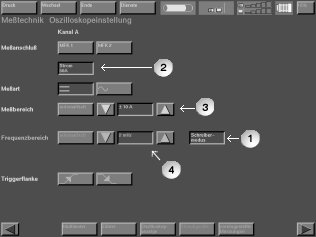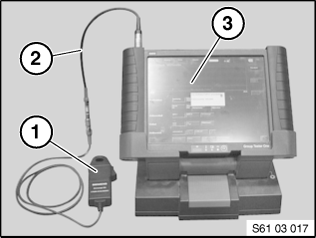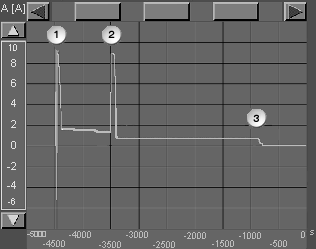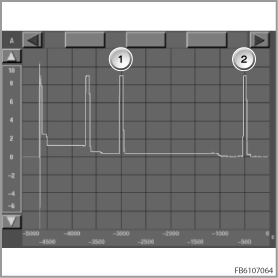Observing sleeping by means of external closed-circuit current measurement
Sporadically or continuously, an increased closed-circuit current can occur in the parked vehicle. Possible causes are:
- An additional current consumer is connected to terminal 30 or the battery.
- Defective component, control unit or peripherals of a control units consumes too much current in the Sleep mode.
Automatic detection of the cause is not possible in the case of a closed-circuit current fault. On vehicles with an intelligent battery sensor, only the range of the closed-circuit current can be determined: < 80 mA, between 80 and 200 mA, between 200 mA and 1 A, > 1 A.
For troubleshooting, an external closed-circuit current measurement is necessary to observe the vehicle going to sleep and to find the cause.
Procedure: external closed-circuit current measurement with measurement system
The GT1, DISplus or MIB oscilloscope with 50 A ammeter clip are very suitable for a long-term measurement of the closed-circuit current.
Vehicle preparation:
Before the measurement, the vehicle must be prepared to ensure good results and avoid possible disturbances during the measurement:
- Park the vehicle in a position where the measurement can be performed without disruption.
- The battery must be adequately charged and the battery charger not connected. If necessary, charge the battery beforehand.
- Open the engine bonnet and pull up the bonnet contact switch (simulation of closed engine bonnet).
- Open the luggage compartment lid and secure the luggage compartment lock with the luggage compartment lid open using a screwdriver or similar (simulation of closed luggage compartment lid).
- Open the glove compartment (detection of consumer shutdown).
- Open the driver's door and close it again (simulates somebody getting in).
- Switch on the ignition for at least 5 seconds and then switch it off again. Remove the remote control or identification sensor for vehicles with Comfort Access from the insert compartment and do not leave it in the vehicle.
- Open the driver's door again and secure the driver's door lock with the driver's door open using a screwdriver or similar (simulation of exit).
- Secure the vehicle.
Setting of the oscilloscope for a long-term measurement:
- Select 'Measurement system' menu: The default setting to measuring cable <MFK1> leads to an error message. Bypass this with <Cancel>.
- The select the 'Oscilloscope setting' screen.

- (1) Activate the recorder mode.
- (2) Select 50 A current.
- (3) Select the measuring range +10 A.
- (4) Select the frequency range: e.g. 0.2 mHz (1 measurement per 10 seconds. This results in a maximum recording duration of 13.8 hours).
Note: The frequency range determines the recording duration of the measured values and the frequency with which the measured values are recorded. The greater the set frequency, the more frequently a measured value is recorded and the shorter the stored recording duration.
- Select the oscilloscope display.
- Connect the 50 A ammeter clip to GT1, DISplus or MIB.
Note: The 50 A ammeter clip is calibrated in accordance with the instructions on the screen of the relevant diagnosis system during the settings. Here, the 50 A ammeter clip must not be connected to the vehicle.
Note: For all long-term measurements, the GT1 must be on the docking station.
e.g. see below for connection of the 50 A ammeter clip (1) with the 2/3 adapter (2) to the GT1 (3):

- Connect the 50 A ammeter clip to the negative battery lead (arrow towards the battery). Then the measurement starts.
Observing the vehicle sleeping and troubleshooting
Regular sleeping
The identifying features (see table below) enable tracking of the vehicle's sleeping.
Sleeping for E60, E61, E63, E64, E87, E90, E91 before model year 03/2006:
No.
|
Time
|
Event
|
Possible identifying features
|
1
|
0 - 3 min
|
Reaching the idle state
|
- Lighting of the START-STOP button goes out.
- Lighting of the child safety switch on the switch block on the driver's door (green LED) goes out.
|
|
3 - 16 min
|
Vehicle sleeping
|
|
2
|
16 - 17 min
|
KBM or FRM wakes the vehicle: Consumer unit shutdown.
|
- Map-reading light goes out.
- Glove-compartment light goes out.
|
|
17 - 30 min or
17 - 60 min
|
Vehicle sleeping
|
|
3
|
30 or 60 min
|
Shutdown of terminal 30g
|
|
Sleeping for E60, E61, E63, E64, E87, E90, E91 as of model year 03/2006 and E92, E93, E81, E70, R56, R55:
No.
|
Time
|
Event
|
Possible identifying features
|
1
|
0 - 3 min
|
Reaching the idle state
|
- Lighting of the START-STOP button goes out.
- Lighting of the child safety switch on the switch block on the driver's door (green LED) goes out.
|
|
3 - 8 min
|
Vehicle sleeping
|
|
2
|
8 - 9 min
|
KBM or FRM wakes the vehicle: Consumer unit shutdown.
|
- Map-reading light goes out.
- Glove-compartment light goes out.
|
|
17 - 30 min or
17 - 60 min
|
Vehicle sleeping
|
|
3
|
30 or 60 min
|
Shutdown of terminal 30g
|
|
In the standard case, terminal 30g is shut down 30 min after <terminal R OFF>. On vehicles with TCU and Telematic services, this takes place 60 min after <terminal. R OFF>.
On vehicles with intelligent battery sensor, the closed-circuit current monitoring starts approx. 70 min after <terminal. R OFF>. The vehicle must be in the idle state for at least another 120 minutes without being wakened so that a new cycle of the closed-circuit current monitoring is saved in the DME/DDE.
Note: If the engine has not run for a certain period, two additional wakings can occur on the E60, E61, E63, E64 and E70 as of model year 03/2007: 40 min (no. 1) and 80 min (no. 2) after <terminal R OFF>, KOMBI (the instrument cluster) wakes the vehicle to check the coolant temperature (see Fig. above). Both wakings are normal and do not lead to a fault code memory entry.
Procedure for troubleshooting
In the event of a closed-circuit current fault, use the following procedure:
- In order to pinpoint the cause (initiator), use the ammeter clip to measure at the supply lines to the distribution boxes at the front and rear and possibly at the supply line for the safety battery terminal. In this way it is possible to determine the area in which the initiator is located.
- At the corresponding distribution box, removing fuses one by one can pinpoint the cause.
As terminal 30g is switched off 30 and/or 60 minutes after <terminal R OFF>, concentrate troubleshooting on the components supplied via terminal 30 and terminal 30g-f.




